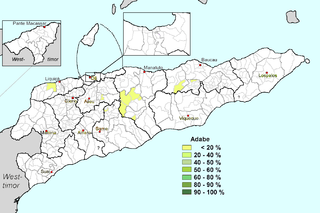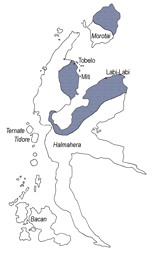Related Research Articles
Most languages of Europe belong to the Indo-European language family. Out of a total European population of 744 million as of 2018, some 94% are native speakers of an Indo-European language. Within Indo-European, the three largest phyla in Europe are Romance, Germanic, and Slavic; they have more than 200 million speakers each and together account for close to 90% of Europeans. Smaller phyla of Indo-European found in Europe include Hellenic, Baltic, Albanian, Celtic, and Armenian ; Indo-Aryan, though a large subfamily of Indo-European, has a relatively small number of speakers in Europe.
In addition to its classical and literary form, Malay had various regional dialects established after the rise of the Srivijaya empire in Sumatra, Indonesia. Also, Malay spread through interethnic contact and trade across the south East Asia Archipelago as far as the Philippines. That contact resulted in a lingua franca that was called Bazaar Malay or low Malay and in Malay Melayu Pasar. It is generally believed that Bazaar Malay was a pidgin, influenced by contact among Malay, Hokkien, Portuguese, and Dutch traders.

Wetarese is an Austronesian language of Wetar, an island in the south Maluku, Indonesia, and of the nearby islands Liran and Atauro, the latter island separate from the mainland of East Timor, north of Dili.

Tobelo is a North Halmahera language spoken on the eastern Indonesian island of Halmahera and on parts of several neighboring islands. The Tobelo-speaking heartland is in the six administrative districts of Tobelo, located on the western shore of Kao Bay and forming the central part of Halmahera Utara Regency. Other Tobelo-speaking areas are the five districts of Wasile on the southern and eastern shores of Kao Bay, and the northern half of Morotai Island. The district capital, also known as Tobelo, serves as a regional commercial and administrative center and is the largest settlement on Halmahera.
Kutai is a Malayic language spoken by 300,000 to 500,000 people. It is the native language of the Kutai people, the indigenous ethnic group which lives along the Mahakam River in Borneo, especially in North Kalimantan, Indonesia. They are the principal population in the regencies of West Kutai, Kutai Kartanegara, and East Kutai within North Kalimantan province.

North Halmahera Regency is a regency of North Maluku Province, Indonesia. It was declared a separate Regency on 31 May 2003, formed from part of the former North Maluku Regency. The capital town of the regency lies at the port of Tobelo. The Regency, which has been considerably reduced by the separation of Morotai Island in 2008, now covers an area of 3,891.62 square kilometres (1,502.56 sq mi) and had a population of 161,847 people at the 2010 Census, 179,783 at the 2015 Intermediate Census. and 197,640 at the 2020 Census. The official estimate as at mid 2022 was 202,755. The principal settlements are Tobelo, Kao and Galela. The area is noted for its white beaches and coral reefs.
Galela is the second most populous Papuan language spoken west of New Guinea, with some 80,000 speakers. Its dialects are Kadai (41,000), Morotai (24,000), Kadina (10,000), and Sopi (4,000). Its closest relative is the Loloda language.
Nimboran is a Papuan language of Nimboran District, Jayapura Regency, Indonesia spoken by mostly older adults. Younger generations have shifted to Papuan Malay. It is spoken in about 26 villages to the west of Lake Sentani.
Nisa and Anasi (Bapu), are dialects of a Papuan language of the Indonesian province of Papua, on the eastern shore of Cenderawasih Bay in Sawai District, Mamberamo Raya Regency. Language use is vigorous.
Waioli is a North Halmahera language of Indonesia.
Modole is a North Halmahera language of Indonesia. The language is spoken in several villages in the Kao region on the northern peninsula of the island of Halmahera.
Tebi, also known by the village name Dubu, is a Western Pauwasi language of West New Guinea. It is spoken in Affi, Dubu, and Jembatan Web villages of Keerom Regency. It is mostly used by older adults.
Woria is a nearly extinct Papuan language of the Indonesian province of Papua, on the eastern shore of Cenderawasih Bay. It is spoken in Botawa village, Waropen Regency, where the Lakes Plain language Saponi was also spoken.
Tefaro is a Papuan language of the Indonesian province of Papua, on the eastern shore of Cenderawasih Bay. It is spoken in Demba and Tefaro villages of Waropen Regency.
Sauri is a Papuan language of the Indonesian province of Papua, on the eastern shore of Cenderawasih Bay. It is spoken in Sauri-Sirami village, Masirei District, Waropen Regency.
Jofotek-Bromnya is a Papuan language of Sarmi Regency, Papua, Indonesia.
Maden is an Austronesian language spoken on the west of Salawati Island, in the Raja Ampat Islands in Indonesian New Guinea.
Gebe, or Minyaifuin, is an Austronesian language of eastern Indonesia, spoken on the islands between Halmahera and Waigeo.
Kola is one of the Aru languages, spoken by inhabitants of the Aru Islands.
Serui-Laut, or Arui, is an Austronesian language spoken on Serui Island of the Ambai Islands, in Western New Guinea, Indonesia.
References
- ↑ Loloda at Ethnologue (18th ed., 2015) (subscription required)
Laba at Ethnologue (18th ed., 2015) (subscription required)